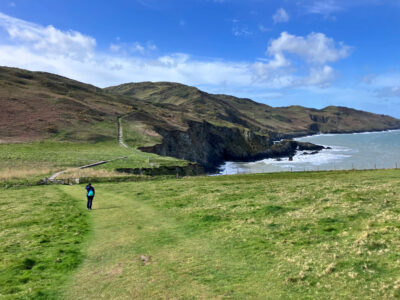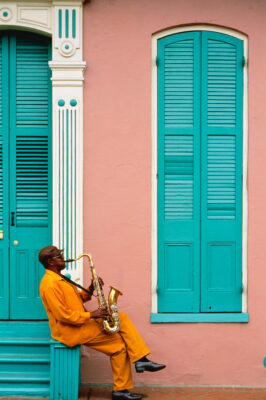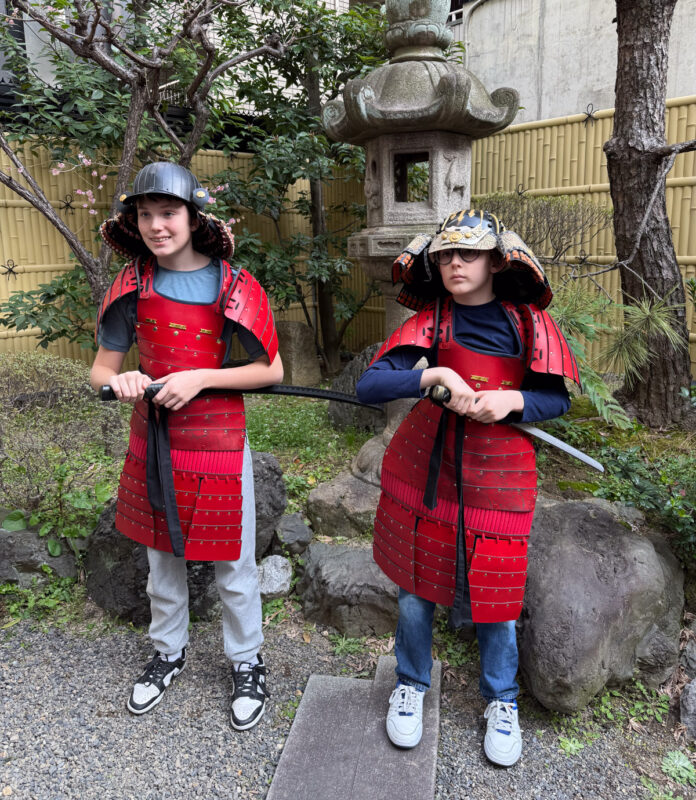
Wanderlust
Tales from the Land of the Samurai (With Apprentices)
Hedgehogs, hot sake, and Hiroshima: two boys and their travel mom take on Japan.
There are lots of different kinds of moms: sports moms, school moms, stage moms. I have come to realize that I am a travel mom.
Having always had an outsize case of wanderlust, I have, hopefully, passed this passion on to my children. Their father is English, so we’ve frequently hopped back and forth across the Atlantic to see family. Flying with small children is no one’s favorite activity (although the shared horror stories serve as good dinner party fodder) but now that they are older, travel has become more of a vacation and less of a “trip”.
It still isn’t always smooth. We have one map where we strike off the countries we’ve visited and another for the ones where the children have thrown up—and there is a lot of overlap between the two. Despite the occasional gastric issues, I’m never prouder of my children than when they are exposed to new experiences, however uncomfortable. I am a firm believer in the power of travel to open all our eyes to the greater world—irrespective of age. However, all previous travel paled in comparison to the big kahuna: our recent two-week trip to Japan.


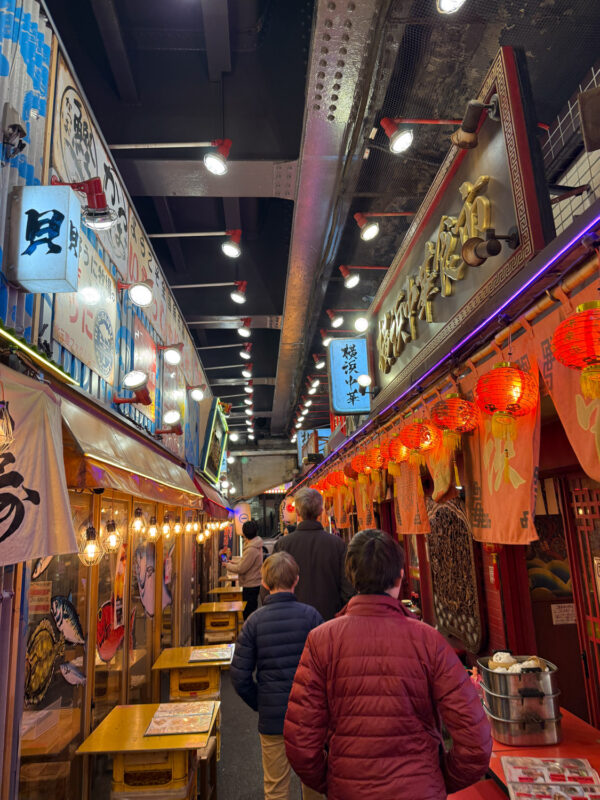
Tokyo: A World Apart
Traveling with children is always an adventure. Traveling with children and a 12-hour jet lag is like being in some giant, out-of-body hallucinatory experience which lasts for days. There is a constant feeling of otherworldliness—it may be because of the day-night reversal or simply the constant reminder that you’re in a different culture.
It’s a crowded city, but for New Yorkers, that’s not such a strange feeling. Everything is the same but a little different. The Shibuya Crossing—the world’s busiest pedestrian intersection—is like a New York City crosswalk on steroids: a giant zigzag where everyone walks in every direction at the same time. I loved that the signal to walk has the sound of birds chirping.
The Unforgettable Pet Cafe
Animal cafes are hugely popular in Japan and there are many different kinds—from cats and dogs to minipigs and penguins. We chose the one with hedgehogs and otters. While much has been written about the bizarreness of getting to interact with animals that normally we see in textbooks or zoos, none focus on a key feature: the smell. The pungent aroma of animals kept in small quarters hits you like a wall the moment you enter—both astringent and overwhelming. (Thankfully, it faded as we adjusted.)
Inside the Harry hedgehog cafe in Harajuku, we encountered no less than 12 or 15 otters. Some jumped between water tubs, racing around, sleek and adorable in their plushiness. Others stayed put in pens, having their bellies stroked by tourists while masked handlers hovered quietly nearby. Hedgehogs sat in troughs, with thick gloves placed beside them for handling. And I almost forgot the owls—two birds chained to posts whose entire purpose seemed to be to have staring contests with clients.
The boys bravely entered the otter pen, feeding treats and rubbing the bellies of these fat, friendly—but surprisingly large toothed—creatures.
I picked up a baby hedgehog, but when it started crawling up my arm, I panicked and dropped it—not terribly hard, but far enough that I felt guilty and didn’t attempt another. Aside from worrying that the animals might not have enough space to roam (there was a lot of pacing—never a good sign), it was as weird and wonderful an experience as one might hope for.


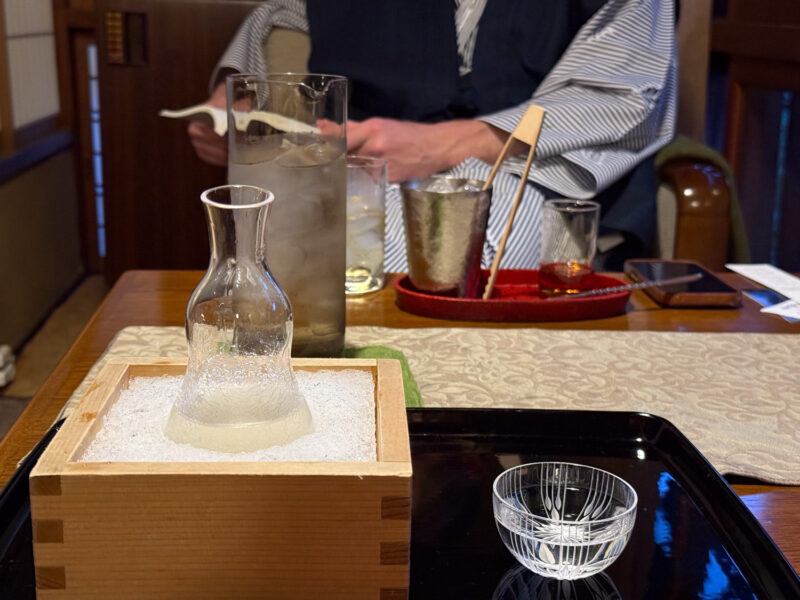
Temples and Traditions
After the pet cafe adventure, there was a family soba-making class where we were taught to make noodles—how to roll the dough and chop it very finely. We didn’t do particularly well, especially me. “No!” said the sensei crossly whenever I didn’t pummel the flour exactly according to his specifications. My children were very amused by this.
We attended a manga workshop (those cool Japanese cartoons) with a proper expert who took our lowly stick-figure drawings and transformed them magically into something resembling a vibrant comic strip.
But our most memorable experience from Tokyo was not on our planned agenda. Everyone visits the Tokyo fish market—it’s a landmark, essentially. But even though we’d had a top tip about where to eat, we foolishly ignored that advice and got dragooned into one of the stands which serves uni exclusively.
Uni—for those unfamiliar—is the edible reproductive organs (roe) of sea urchins and it’s considered a delicacy in Japan. Typically, one is given just a small amount to try but at this cafe, carefully measured out gobs of it were smeared over everything they served us. After the eighth or ninth piece of uni-slathered sushi, we were praying for it to be over. Finally, the chef served us what looked like a plain plate of tuna sashimi on a bed of white rice, but no, we couldn’t escape even that. He turned towards us and said, “Almost forgot,” sticking a massive mound of the yellowish ooze on top.
Harry, 13, ate it all—every last bite—with not a word of complaint, he was so worried about upsetting the chef. (Theo, 10, very sensibly just ate white rice—his staple for most of the trip). We also got sucker-punched by the bill, which came in at around $600 for this “experience.”
After our culinary adventure we took one of the many Shinkansen—those futuristic bullet trains which look like giant snake–squids pulling into the station—to Takayama, a mountain town a few hours outside Tokyo. We set off on a magical bike ride through the rice paddies in a nearby town, Hida-Furukawa, surrounded on either side by the Japanese Alps. We learned that families still have their own individual paddies, like funeral plots that get passed down for generations. Takayama is known for its sake distilleries which have been around for nearly a century. The wooden buildings that line the streets look like they’ve been transported back from 19th century Japan.

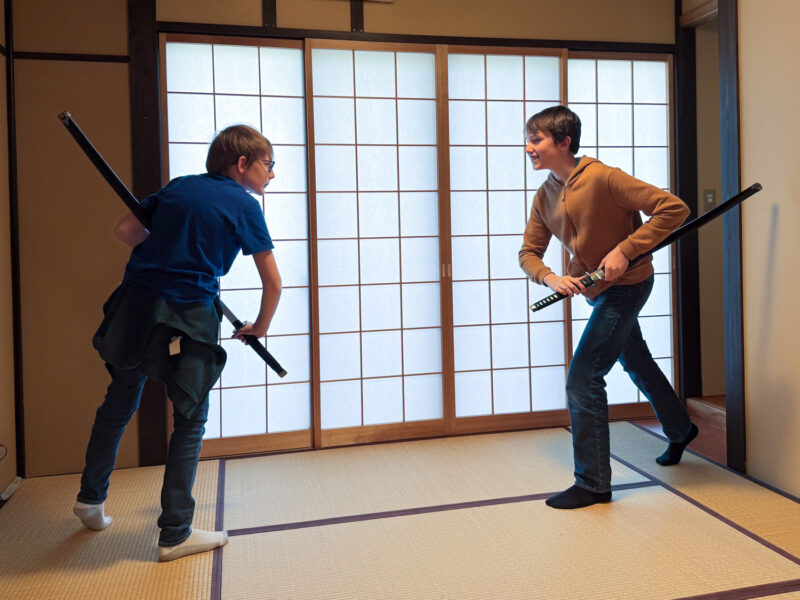
A Memorable Meal
We waited outside in the freezing weather for about 20 minutes to eat in at Suzuya Restaurant, sure we must have made the wrong decision. The place was small and cramped with tables low to the floor and posters of warriors on the walls—and cold inside despite the space heaters. The steak—Hida wagyu beef—came in tiny pieces, to be cooked on an individual charcoal grill. It was so good I think I would remember it as the reason to come back. Accompanied by cabbage, pickles, and a bottle of hot sake—most of which I consumed rapidly to warm myself up—the memory of the mouth-meltingly good beef will endure.
The Charm of Kyoto
Kyoto is a lovely city, small and easy to navigate, with loads of young people as it’s essentially a university town. Spared from bombing during WWII, it retains a glamour and mystery from a bygone era.
We stayed at the wonderfully charming Hiiragiya Ryokan, which has been in the same family for six generations, in rooms whose size was determined by “mat” size—literally straw mats on the floor which went up in increments of two: eight mats for one room and ten for another. We slept on futons on the floor; the boys loved them.
Every room had an onsen (Japanese bath) which always seemed to stay at a perfect—just below scalding—temperature. Every night, we’d go downstairs in our slippers (no shoes allowed) and Japanese robes, helped by an attendant in a pink kimono. In the afternoons, the ladies would serve us tea and biscuits, in an elaborate ceremony. My boys had contrasting reactions to it all: Harry loved it; Theo thought all the extra help a bit much.
Traveling back in time is a bit of a thing in Kyoto, which we noticed when we visited Gion, the street where the geishas live and work. The town once housed 80,000 but their numbers have greatly dwindled—to around 800 now. Tourists thronged the streets, hoping to catch a glimpse of these ladies as they sprinted between appointments. Fragrances from flowering apple and apricot trees perfumed the air.
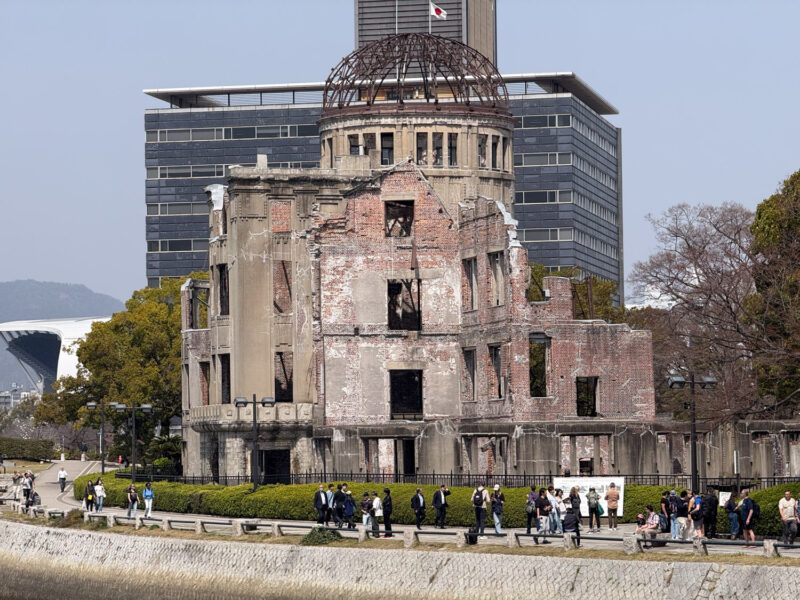

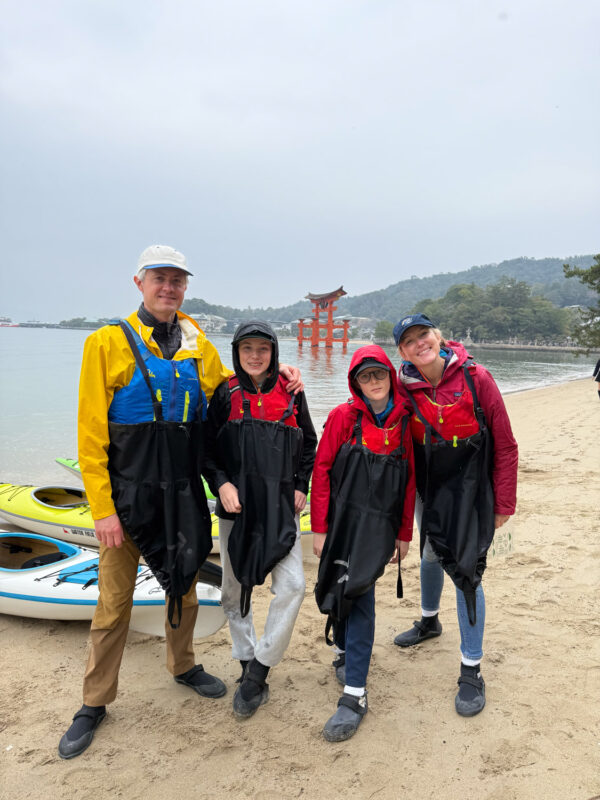
History in Hiroshima
Our final stop was Hiroshima. We’d considered skipping it but I felt it was important, as an American, to see the city in person.
The A-Bomb at Peace Memorial Park (a UNESCO World Heritage Site) is a sight not easily forgotten. The barest of structures, it was one of the only buildings left standing on August 6, 1945, when the first bomb was dropped on the city, and its skeletal dome remains are a stark reminder of the horror of that moment.
The museum was even more searing. The images of burned people and pieces of children’s clothing and shoes, accompanied by translated texts of their diaries or memories, were hard to process. But it felt incredibly important to attempt to appreciate the extent of suffering. How else can we hope to avoid such tragedies in the future?
On our last day we kayaked near the island of Miyajima, close to the great Torri gates which seemed to float on the water. It was a long paddle, and we passed oyster beds with a full view of the Miyajima’s hills, dotted with deer and flowers. Harry and I shared a kayak and together we heaved ho—sometimes in unison and sometimes smacking our oars hopelessly together—but we got there eventually. Together with my boys and husband is a memory I’ll always treasure.

